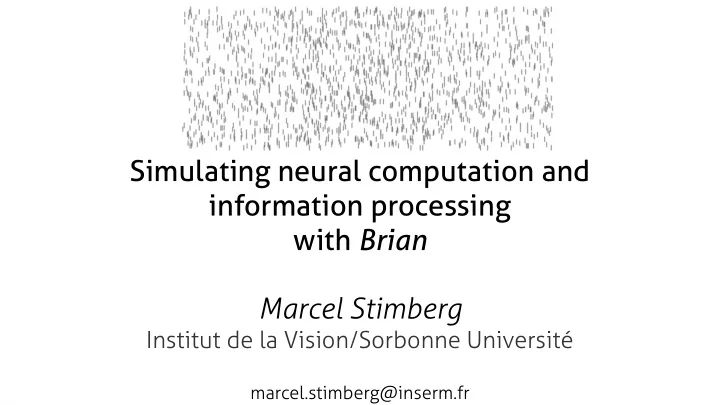

Simulating neural computation and information processing with Brian Marcel Stimberg Institut de la Vision/Sorbonne Université marcel.stimberg@inserm.fr
Course material Updated material will be uploaded here: g i t h u b . c o m / b r i a n - t e a m / b r i a n - m a t e r i a l / t r e e / m a s t e r / 2 0 1 9 - T D - B r i a n - S o r b o n n e To download everything in a single ZIP fjle (includes material from other courses as well): g i t h u b . c o m / b r i a n - t e a m / b r i a n - m a t e r i a l / a r c h i v e / m a s t e r . z i p To download individual jupyter notebook fjles, make sure to switch to “raw” view
Plan for today ● Introductjon to modelling with Brian Interactjve tutorial (“live coding”): ● The jupyter notebook ● Part 1: Modelling neurons ● Part 2: Modelling synapses
Modelling networks of neurons Individual elements Detailed neuronal morphologies � point-neuron models
Modelling networks of neurons Individual elements Point-neuron models activity input Hodgkin-Huxley formalism integrate-and-fjre model fjring rate models
Modelling networks of neurons Synapses membrane potential “delta synapse”
Modelling networks of neurons Synapses synaptic current membrane potential “delta synapse” exponential current-based
Modelling networks of neurons Synapses synaptic synaptic current membrane potential conductance “delta synapse” exponential current-based exponential conductance-based
The simulator
Who is Brian? Simulator for spiking neuronal networks, written in Python ● Started by Dan Goodman and Romain Brette at ENS Paris in 2007 ● “A simulator should not only save the time of processors, but also ● the time of scientists” Does not provide a library of fjxed models but allows for a fmexible ● defjnition of (almost) arbitrary models Focusses on “medium-sized” neuronal networks ● (“a few” to ~100000 neurons), simulations on standard PCs, not supercomputers Tool for research and teaching ● Free-and-open-source ●
Brian's approach ● Philosophy : Mathematical model descriptions – Flexible system to defjne models instead of library of prepared models – Explicit about model details – Mathematical notation, physical units ● Technology : Code generation – High-level descriptions transformed into low-level code – Modular architecture allows for extensions (e.g. to run code on GPU)
Example: neuron model
Example synapse model exponential, current-based synapse: when a spike arrives, increase I syn by 0.1nA dI syn dt =− I syn ● τ syn between spikes, decay exponentially with τ syn ●
More info Docum cument ntation: https://brian2.readthedocs.io Mailing list st: briansupport@googlegroups.com Art Articles: s: Stimberg, Marcel, Romain Brette, and Dan FM Goodman. “Brian 2, an Intuitive and Effjcient Neural Simulator.” ELife 8 (2019): e47314. https://doi.org/10.7554/eLife.47314. Stimberg, Marcel, Dan F. M. Goodman, Victor Benichoux, and Romain Brette. “Equation-Oriented Specifjcation of Neural Models for Simulations.” Frontiers in Neuroinformatics 8 (2014). https://doi.org/10.3389/fninf.2014.00006
Recommend
More recommend